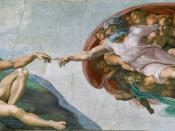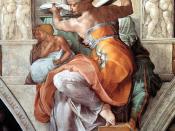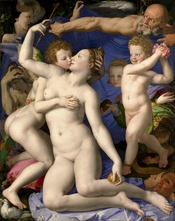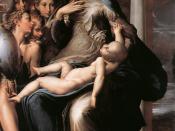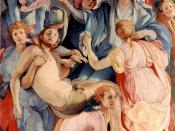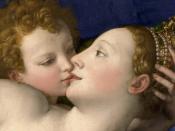Mannerism is the artistic style that appeared as the same time with the high renaissance in middle to late sixteenth century. It was the turning point for us to look at something we like fond of, something do not related to the church or religious. Mannerism art was considered formulaic, theatrical and overly stylized work, characterized by a complex composition, with contrasting color and different meaning compare with the traditional art.
Lawrence in his book Culture and Values A Survey of the Humanities, stated that "Mannerism is difficult to define and the term is often used without any precise sense"(328). Comparing with the high renaissance traditional art, the mannerism art is totally different in many ways. For example: The entrance to the Laurentian Library painted by Michelangelo in 1524 show us the strange landscapes as well as the composition: Windows are not real windows, the column stand just for decorate and the staircase being rounded with three path.
These things put us a question, why windows and column had been created for nothing, in other words, useless and the same for the staircase, three path lead to one door is some kinds of wasting or not logical. But that something so-called mannerism. In addition, the mannerism panting was innovative in the way of using color too. In the painting Deposition painted around 1528 for the Church of Santa Felicita in Florence, according to the author "The most striking feature of this work is its shocking colors: pinks, apple-greens, washed-out blues. It is hard to think of any other Renaissance painting to which this stunningly original and exotic work can be compared"(329). Indeed, not only the color that the artist used but the meaning of the figure was something unresolved. Look at this painting the viewer could see the facial expression, the painter wanted to emphasize the horror and strangeness. They seem to be in the middle of the air with unknown location. But the most dramatic painting is Madonna of the Long Neck of Francesco Mazzola. In the painting, the baby looks almost dead with his left arm aim to the ground. About the Madonna, she seems very sexy with many curves in her breast, especially her S shape neck along with her long and curvedly finger. Behind Madonna is a column which stands for nothing. Why the column always have to support the ceiling. These paintings probably tell us that this is the time to say goodbye with the church.
Henry in his book A World of Art, stated that "Highly individualistic and mannered, or consciously artificial, this Mannerist style was dedicated to "invention", and the technical and imaginative virtuosity of the artist became of paramount importance. Each Mannerist artist may, therefore, be identified by his own "signature" style. Where the art of the High Renaissance sought to create a feeling of balance and proportion, quite the opposite of the goal of Mannerism art"(475). Michelangelo who had painted the fresco of the Last Judgment on the altar wall of the Sistine Chapel. We can find in the proposition of this figure that the crow is arranged very chaotic in every space of the painting, they also seem can fall from the sky to the ground anytime. "Often the space of a Mannerist painting seems to shallow for what is depicted, a feeling emphasized by the frequent use of radical foreshortening"(476). In Venus, Cupid, Folly and Time painted by Bronzino's, the viewer could see the color like the author said "The colors are often bright and clashing"(476). The mannerist evident here is the distant between the head and shoulder of Cupid's.
In brief, Mannerism is a voice of freedom of some people at that time. They want to live, not to exist and time to say goodbye with religious and the church has come. Mannerism is also demonstrated for human imagination and creativity that mannerist call hand-made not god-made.
Work cited:Lawrence Cunningham and John Reich, Culture and Values A Survey of the Humanities, Thomson Wadsworth, 2005Sayre Henry, A World of Art. Prentice Hall, 2007
